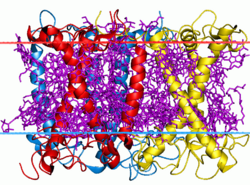Biology:Light-harvesting complexes of green plants
| Chlorophyll A-B binding protein | |||||||||
|---|---|---|---|---|---|---|---|---|---|
 Light-Harvesting Complex II (LHCB) | |||||||||
| Identifiers | |||||||||
| Symbol | Chloroa_b-bind | ||||||||
| Pfam | PF00504 | ||||||||
| InterPro | IPR022796 | ||||||||
| SCOP2 | 1rwt / SCOPe / SUPFAM | ||||||||
| OPM superfamily | 2 | ||||||||
| OPM protein | 1rwt | ||||||||
| |||||||||
The light-harvesting complex (or antenna complex; LH or LHC) is an array of protein and chlorophyll molecules embedded in the thylakoid membrane of plants and cyanobacteria, which transfer light energy to one chlorophyll a molecule at the reaction center of a photosystem.
The antenna pigments are predominantly chlorophyll b, xanthophylls, and carotenes. Chlorophyll a is known as the core pigment. Their absorption spectra are non-overlapping and broaden the range of light that can be absorbed in photosynthesis. The carotenoids have another role as an antioxidant to prevent photo-oxidative damage of chlorophyll molecules. Each antenna complex has between 250 and 400 pigment molecules and the energy they absorb is shuttled by resonance energy transfer to a specialized chlorophyll-protein complex known as the reaction center of each photosystem.[1] The reaction center initiates a complex series of chemical reactions that capture energy in the form of chemical bonds.
For photosystem II, when either of the two chlorophyll a molecules at the reaction center absorb energy, an electron is excited and transferred to an electron acceptor molecule, pheophytin, leaving the chlorophyll a in an oxidized state. The oxidised chlorophyll a replaces the electrons by photolysis that involves the oxidation of water molecules to oxygen, protons and electrons.
The N-terminus of the chlorophyll a-b binding protein extends into the stroma where it is involved with adhesion of granal membranes and photo-regulated by reversible phosphorylation of its threonine residues.[2] Both these processes are believed to mediate the distribution of excitation energy between photosystems I and II.
This family also includes the photosystem II protein PsbS, which plays a role in energy-dependent quenching that increases thermal dissipation of excess absorbed light energy in the photosystem.[3]
LH 1
Light-harvesting complex I is permanently bound to photosystem I via the plant-specific subunit PsaG. It is made up of four proteins: Lhca1, Lhca2, Lhca3, and Lhca4, all of which belong to the LHC or chlorophyll a/b-binding family. The LHC wraps around the PS1 reaction core.[4]
LH 2
The LH 2 is usually bound to photosystem II, but it can undock and bind PS I instead depending on light conditions.[4] This behavior is controlled by reversible phosphorylation. This reaction represents a system for balancing the excitation energy between the two photosystems.[5]
References
- van Amerongen, H., Croce, R. Light harvesting in photosystem II. Photosynth Res 116, 251–263 (2013). https://doi.org/10.1007/s11120-013-9824-3
- ↑ Biochemistry 4th Ed.. USA: Wiley. 2011. pp. 906. ISBN 978-0470-57095-1. https://archive.org/details/biochemistrythed00voet.
- ↑ "The N-terminal domain of the light-harvesting chlorophyll a/b-binding protein complex (LHCII) is essential for its acclimative proteolysis". FEBS Letters 466 (2–3): 385–8. January 2000. doi:10.1016/S0014-5793(00)01107-8. PMID 10682866.
- ↑ "Regulation of photosynthetic light harvesting involves intrathylakoid lumen pH sensing by the PsbS protein". The Journal of Biological Chemistry 279 (22): 22866–74. May 2004. doi:10.1074/jbc.M402461200. PMID 15033974.
- ↑ 4.0 4.1 "Photosystem I". Encyclopedia of biological chemistry (Second ed.). London. 2013. pp. 503–507. doi:10.1016/B978-0-12-378630-2.00287-5. ISBN 978-0-12-378630-2.
- ↑ "NaCl-induced phosphorylation of light harvesting chlorophyll a/b proteins in thylakoid membranes from the halotolerant green alga, Dunaliella salina". FEBS Letters 569 (1–3): 337–40. July 2004. doi:10.1016/j.febslet.2004.05.065. PMID 15225658.
See also
 |

